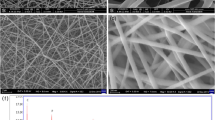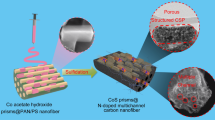Abstract
The development of advanced electrode materials for sodium-ion batteries (SIBs) is crucial for the progression of energy storage technologies. In this study, we successfully fabricated V5S8/CoS nanoparticles confined within self-supported carbon nanofibers (CNFs) using a facile electrospinning method followed by a sulfidation process. Extensive characterization of the resulting V5S8/CoS-CNFs revealed their unique structural attributes, featuring a one-dimensional nanofiber morphology with enhanced Na+ transport pathways. In addition, V5S8 and CoS are typical semiconductors and have greater compatibility at the interface, which can enhance the synergistic effect in the composite. These V5S8/CoS-CNFs exhibited a remarkable reversible capacity of 201 mAh g−1 even at a high current density of 5 A g−1, along with a stable cycling performance of 165 mAh g−1 after 300 cycles at 2 A g−1. The incorporation of both V5S8 and CoS within the nanofiber structure substantially enhanced the pseudocapacitance effect, thereby improving sodium storage capabilities. The exceptional electrochemical properties of the binder-free V5S8/CoS-CNFs anode can be attributed to its heterogeneous composition embedded within CNFs. This composition effectively boosts the rate of sodium ion diffusion by generating a built-in electric field (BEF) at the V5S8 and CoS interface, alleviating volume stress during charge–discharge processes and enhancing overall conductivity. Our findings underscore the potential of V5S8/CoS-CNFs as high-performance anode materials for SIBs, offering valuable insights into the design and development of advanced electrode materials for future energy storage applications.






Similar content being viewed by others
Data availability
Data will be made available on request.
References
Zhang W, Lu J, Guo Z (2021) Challenges and future perspectives on sodium and potassium ion batteries for grid-scale energy storage. Mater Today 50:400–417. https://doi.org/10.1016/j.mattod.2021.03.015
Liu C, Neale ZG, Cao G (2016) Understanding electrochemical potentials of cathode materials in rechargeable batteries. Mater Today 19:109–123. https://doi.org/10.1016/j.mattod.2015.10.009
Liu C, Qiu Y, Liu Y et al (2022) Novel 3D grid porous Li4Ti5O12 thick electrodes fabricated by 3D printing for high performance lithium-ion batteries. J Adv Ceram 11:295–307. https://doi.org/10.1007/s40145-021-0533-7
Li M, Lu J, Ji X et al (2020) Design strategies for nonaqueous multivalent-ion and monovalent-ion battery anodes. Nat Rev Mater 5:276–294. https://doi.org/10.1038/s41578-019-0166-4
Zhao L, Zhang T, Li W et al (2022) Engineering of sodium-ion batteries: opportunities and challenges. Engineering. https://doi.org/10.1016/j.eng.2021.08.032
Xia Q, Li W, Miao Z, Chou S, Liu H (2017) Phosphorus and phosphide nanomaterials for sodium-ion batteries. Nano Res 10:4055–4081. https://doi.org/10.1007/s12274-017-1671-7
Ni J, Li L (2018) Self-supported 3D array electrodes for sodium microbatteries. Adv Funct Mater 28. https://doi.org/10.1002/adfm.201704880
Brehm W, Santhosha AL, Zhang Z et al (2020) Copper thiophosphate (Cu3PS4) as electrode for sodium-ion batteries with ether electrolyte. Adv Funct Mater 30. https://doi.org/10.1002/adfm.201910583
Li S, He W, Liu B et al (2020) One-step construction of three-dimensional nickel sulfide-embedded carbon matrix for sodium-ion batteries and hybrid capacitors. Energy Storage Mater 25:636–643. https://doi.org/10.1016/j.ensm.2019.09.021
Guan B, Qi S-Y, Li Y, Sun T, Liu Y-G, Yi T-F (2021) Towards high-performance anodes: design and construction of cobalt-based sulfide materials for sodium-ion batteries. J Energy Chem 54:680–698. https://doi.org/10.1016/j.jechem.2020.06.005
Zhang X, He Q, Xu X et al (2020) Insights into the storage mechanism of layered VS2 cathode in alkali metal-ion batteries. Adv Energy Mater 10. https://doi.org/10.1002/aenm.201904118
Gao H, Niu J, Zhang C, Peng Z, Zhang Z (2018) A dealloying synthetic strategy for nanoporous bismuth–antimony anodes for sodium ion batteries. ACS Nano 12:3568–3577. https://doi.org/10.1021/acsnano.8b00643
Ni J, Sun M, Li L (2019) Highly efficient sodium storage in iron oxide nanotube arrays enabled by built-in electric field. Adv Mater 31. https://doi.org/10.1002/adma.201902603
Li W, Song Q, Li M et al (2021) Chemical heterointerface engineering on hybrid electrode materials for electrochemical energy storage. Small Methods 5. https://doi.org/10.1002/smtd.202100444
Wang S, Liu S, Li X et al (2018) SnS2/Sb2S3 heterostructures anchored on reduced graphene oxide nanosheets with superior rate capability for sodium-ion batteries. Chem Eur J 24:3873–3881. https://doi.org/10.1002/chem.201705855
Yeol Jo D, Park S-K (2022) Constructing hollow CoSe2/SnSe2 heterostructures covered with N-doped carbon shell for high-efficiency potassium-ion storage. Appl Surf Sci 571. https://doi.org/10.1016/j.apsusc.2021.151293
Oh HG, Park SK (2022) Co-MOF derived MoSe2@CoSe2/N-doped carbon nanorods as high-performance anode materials for potassium ion batteries. Int J Energy Res 46:10677–10688. https://doi.org/10.1002/er.7866
Du P, Cao L, Zhang B et al (2021) Recent progress on heterostructure materials for next-generation sodium/potassium ion batteries. Renewable Sustainable Energy Rev 151. https://doi.org/10.1016/j.rser.2021.111640
Lim JB, Kim M, Park S-K (2022) Construction of N-doped multichannel carbon nanofibers embedded with amorphous VS4 nanoparticles for potassium-ion batteries with ultralong-term cycling stability. Appl Surf Sci 602. https://doi.org/10.1016/j.apsusc.2022.154332
Zhang W, Yue Z, Miao W et al (2018) Carbon-encapsulated tube-wire Co3O4/MnO2 heterostructure nanofibers as anode material for sodium-ion batteries. Part Part Syst Charact 35. https://doi.org/10.1002/ppsc.201800138
Wang L, Yang G, Peng S, Wang J, Yan W, Ramakrishna S (2020) One-dimensional nanomaterials toward electrochemical sodium-ion storage applications via electrospinning. Energy Storage Mater 25:443–476. https://doi.org/10.1016/j.ensm.2019.09.036
Hou Z-d, Gao Y-y, Zhang Y, Wang J-g (2023) Research progress on freestanding carbon-based anodes for sodium energy storage. New Carbon Mater 38:230–243. https://doi.org/10.1016/s1872-5805(23)60725-5
Homaeigohar S, Davoudpour Y, Habibi Y, Elbahri M (2017) The electrospun ceramic hollow nanofibers. Nanomaterials 7. https://doi.org/10.3390/nano7110383
Li L, Peng S, Lee JKY, Ji D, Srinivasan M, Ramakrishna S (2017) Electrospun hollow nanofibers for advanced secondary batteries. Nano Energy 39:111–139. https://doi.org/10.1016/j.nanoen.2017.06.050
Wang Y, Liu Y, Liu Y et al (2021) Recent advances in electrospun electrode materials for sodium-ion batteries. J Energy Chem 54:225–241. https://doi.org/10.1016/j.jechem.2020.05.065
Liu H, He Y, Cao K et al (2021) Stimulating the reversibility of Sb2S3 anode for high-performance potassium-ion batteries. Small 17. https://doi.org/10.1002/smll.202008133
Liu H, He Y, Zhang H et al (2021) Lowering the voltage-hysteresis of CuS anode for Li-ion batteries via constructing heterostructure. Chem Eng J 425. https://doi.org/10.1016/j.cej.2021.130548
Cao K, Zheng R, Wang S et al (2020) Boosting coulombic efficiency of conversion-reaction anodes for potassium-ion batteries via confinement effect. Adv Funct Mater 30. https://doi.org/10.1002/adfm.202007712
Liu H, He Y, Zhang H et al (2021) Bi-continuous ion/electron transfer avenues enhancing the rate capability of SnS2 anode for potassium-ion batteries. J Power Sources 506. https://doi.org/10.1016/j.jpowsour.2021.230160
Chen W, Liu X, Wu J et al (2023) Electrospun Fe1-xS@nitrogen-doped carbon fibers as anode material for sodium-ion batteries. J Electroanal Chem 929. https://doi.org/10.1016/j.jelechem.2022.117095
Wanjun T, Donghua C (2007) Mechanism of thermal decomposition of cobalt acetate tetrahydrate. Chem Pap 61. https://doi.org/10.2478/s11696-007-0042-3
Yang M, Su D, Zhang W et al (2021) Potassium storage mechanism of In2S3/C nanofibers as the anode for potassium ion batteries. Electrochim Acta 400. https://doi.org/10.1016/j.electacta.2021.139461
Wang S, Yang Y, Quan W et al (2017) Ti3+-free three-phase Li4Ti5O12/TiO2 for high-rate lithium ion batteries: capacity and conductivity enhancement by phase boundaries. Nano Energy 32:294–301. https://doi.org/10.1016/j.nanoen.2016.12.052
Fang G, Wu Z, Zhou J et al (2018) Observation of pseudocapacitive effect and fast ion diffusion in bimetallic sulfides as an advanced sodium-ion battery anode. Adv Energy Mater 8. https://doi.org/10.1002/aenm.201703155
Zhao N, Qin J, Chu L et al (2020) Heterogeneous interface of Se@Sb@C boosting potassium storage. Nano Energy 78. https://doi.org/10.1016/j.nanoen.2020.105345
Cheng Y, Huang J, Li J et al (2019) SnSe/r-GO composite with enhanced pseudocapacitance as a high-performance anode for Li-ion batteries. ACS Sustainable Chem Eng 7:8637–8646. https://doi.org/10.1021/acssuschemeng.9b00441
Yang C, Ou X, Xiong X et al (2017) V5S8-graphite hybrid nanosheets as a high rate-capacity and stable anode material for sodium-ion batteries. Energy Environ Sci 10:107–113. https://doi.org/10.1039/c6ee03173k
Xu L, Chen X, Guo W et al (2021) Co-construction of sulfur vacancies and carbon confinement in V5S8/CNFs to induce an ultra-stable performance for half/full sodium-ion and potassium-ion batteries. Nanoscale 13:5033–5044. https://doi.org/10.1039/d0nr08788b
Guan B, Yang S-J, Tian S-H, Sun T, Wang P-F, Yi T-F (2023) In-situ-grown multidimensional Cu-doped Co1-S2@MoS2 on N-doped carbon nanofibers as anode materials for high-performance alkali metal ion batteries. J Colloid Interface Sci 650:369–380. https://doi.org/10.1016/j.jcis.2023.07.002
Yan Z, Sun Z, Qiu Y et al (2022) In situ F doping-induced multilayer FeS2@CoS@C hierarchical heterostructures for ultrafast lithium storage. Mater Today Energy 29. https://doi.org/10.1016/j.mtener.2022.101108
Zhang S, Zhao H, Wang M, Li Z, Mi J (2018) Low crystallinity SnS encapsulated in CNTs decorated and S-doped carbon nanofibers as excellent anode material for sodium-ion batteries. Electrochim Acta 279:186–194. https://doi.org/10.1016/j.electacta.2018.05.082
Lu H, Wu L, Xiao L, Ai X, Yang H, Cao Y (2016) Investigation of the effect of fluoroethylene carbonate additive on electrochemical performance of Sb-based anode for sodium-ion batteries. Electrochim Acta 190:402–408. https://doi.org/10.1016/j.electacta.2015.12.136
Fan R, Zhao C, Ma J et al (2022) Rich self‐generated phase boundaries of heterostructured VS4/Bi2S3@C nanorods for long lifespan sodium-ion batteries. Small 18. https://doi.org/10.1002/smll.202205175
Zhang X, Jie Liu X, Wang G, Wang H (2017) Cobalt disulfide nanoparticles/graphene/carbon nanotubes aerogels with superior performance for lithium and sodium storage. J Colloid Interface Sci 505:23–31. https://doi.org/10.1016/j.jcis.2017.05.028
Liu S, Zhang H, Zhou M, Chen X, Sun Y, Zhang Y (2021) V5S8 nanoparticles anchored on carbon nanofibers for fast and durable sodium and potassium ion storage. J Electroanal Chem 903. https://doi.org/10.1016/j.jelechem.2021.115841
Zhang W, Yue Z, Wang Q et al (2020) Carbon-encapsulated CoS2 nanoparticles anchored on N-doped carbon nanofibers derived from ZIF-8/ZIF-67 as anode for sodium-ion batteries. Chem Eng J 380. https://doi.org/10.1016/j.cej.2019.122548
Chen H, Li Y, Liu R et al (2023) Novel porous CoS1.097@carbon nanofibers as flexible and binder-free anode material for sodium-ion batteries. J Alloys Compd 956. https://doi.org/10.1016/j.jallcom.2023.170341
Li W, Huang J, Feng L et al (2017) Facile in situ synthesis of crystalline VOOH-coated VS2 microflowers with superior sodium storage performance. J Mater Chem A 5:20217–20227. https://doi.org/10.1039/c7ta05205g
Zhang Y, Wang N, Sun C et al (2018) 3D spongy CoS2 nanoparticles/carbon composite as high-performance anode material for lithium/sodium ion batteries. Chem Eng J 332:370–376. https://doi.org/10.1016/j.cej.2017.09.092
Li W, Huang J, Cao L, Feng L, Yao C (2018) Controlled construction of 3D self-assembled VS4 nanoarchitectures as high-performance anodes for sodium-ion batteries. Electrochim Acta 274:334–342. https://doi.org/10.1016/j.electacta.2018.04.106
Sun R, Qin Z, Li Z, Fan H, Lu S (2020) Binary zinc-cobalt metal-organic framework derived mesoporous ZnCo2O4@NC polyhedron as a high-performance lithium-ion battery anode. Dalton Trans 49:14237–14242. https://doi.org/10.1039/d0dt03132a
Feng Y, Xu M, He T et al (2021) CoPSe: a new ternary anode material for stable and high-rate sodium/potassium-ion batteries. Adv Mater 33. https://doi.org/10.1002/adma.202007262
Tang L-b, Zhang B, Peng T et al (2021) MoS2/SnS@C hollow hierarchical nanotubes as superior performance anode for sodium-ion batteries. Nano Energy 90. https://doi.org/10.1016/j.nanoen.2021.106568
Wang B, Cheng Y, Su H et al (2020) Boosting transport kinetics of cobalt sulfides yolk–shell spheres by anion doping for advanced lithium and sodium storage. Chemsuschem 13:4078–4085. https://doi.org/10.1002/cssc.202001261
Zhu J, Wang J, Li G, Huang L, Cao M, Wu Y (2020) Heterogeneous structured pomegranate-like Bi@C nanospheres for high-performance sodium storage. J Mater Chem A 8:25746–25755. https://doi.org/10.1039/d0ta09164b
Mahmood A, Li S, Ali Z et al (2019) Ultrafast sodium/potassium-ion intercalation into hierarchically porous thin carbon shells. Adv Mater 31. https://doi.org/10.1002/adma.201805430
Liu Y, Xu Y, Han Y et al (2019) Facile synthesis of SnSe2 nanoparticles supported on graphite nanosheets for improved sodium storage and hydrogen evolution. J Power Sources 436. https://doi.org/10.1016/j.jpowsour.2019.226860
Acknowledgements
The Zhejiang Provincial Key R&D Program (Grant No. 2023C04045) provided financial assistance for this project.
Author information
Authors and Affiliations
Contributions
Junjie Dai: experimental design, method research, data arrangement, investigation and analysis, paper writing. Fangshun Zhu: implementation of the experimental process, data collection, data collation, paper revision. Balaji Murugesan: research implementation, paper design, paper revision, technical support. Qing Zhang: experimental assistance, data acquisition. Xiaochong Zhou and Wenbin Ni: statistical analysis, research and technical support. Yurong Cai: programme design, project management, guidance support, final review of papers, funding.
Corresponding authors
Ethics declarations
Ethics approval and consent to participate
Not applicable.
Competing interests
The authors declare no competing interests.
Additional information
Publisher's Note
Springer Nature remains neutral with regard to jurisdictional claims in published maps and institutional affiliations.
Supplementary Information
Below is the link to the electronic supplementary material.
Rights and permissions
Springer Nature or its licensor (e.g. a society or other partner) holds exclusive rights to this article under a publishing agreement with the author(s) or other rightsholder(s); author self-archiving of the accepted manuscript version of this article is solely governed by the terms of such publishing agreement and applicable law.
About this article
Cite this article
Dai, J., Zhu, F., Murugesan, B. et al. Synergistic V5S8/CoS nanoparticles-embedded carbon nanofiber as binder-free flexible anode for sodium-ion batteries. Ionics 30, 217–227 (2024). https://doi.org/10.1007/s11581-023-05268-5
Received:
Revised:
Accepted:
Published:
Issue Date:
DOI: https://doi.org/10.1007/s11581-023-05268-5




